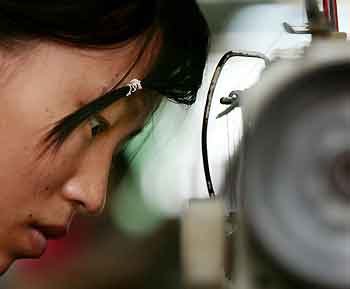
| HOME | EXPORT & IMPORT |TEXTILE ACTS | RESOURCES | DIRECTORY |SITE MAP |
|
Dynamic heat and water transfer through layered fabrics
Garments manufactured for specific activities are growing worldwide. Many synthetic fibers produced by chemical processes are offered on the market, and clothes can be manufactured from numerous combinations of natural and synthetic fibers. Many different kinds of clothing are adapted for particular uses: sports, industrial jobs, very hot or very cold weather. The comfort of a garment is linked to several factors: lightness, heat and vapor transport, sweat absorption and drying, wind and impermeability. For example, winter sport clothes must have good vapor transfer properties. A garment's comfort depends on the properties each of fabric layer and the combination of all the layers worn. Each particular garment-for example, a trenchcoat or a raincoat-has several different layers: an external waterproof layer, an internal lining, and sometimes an intermediate layer. To create a high performance garment, a designer considers fashion and other technical factors: fiber nature and size (microfibers that have particular properties), surface modification of fibers (hydrophobic or hydrophilic treatments), hydrophobic (Gortex, for example) or hydrophilic membranes fused to a textile layer, weaving or knitting patterns, and abrasion of the fabric surface. To know how heat and water are transported through each fabric, measurements of their physical properties (heat conductivity, vapor diffusivity, air permeability ... ) must be made in laboratories. In this paper, we propose mathematical models to simulate the response of layered fabrics subjected to heat and sweating conditions. Aims of the Model Heat and water transfer in textile layers involves two kinds of mathematical models. The first, more frequently referred in the literature, is either the Nordon-David model or a derived form of it [2, 19]. Based on conservation equations, this global model consists of two differential coupled equations with variables for temperature and water concentration in air (Ca) and in the fibers of the textile (Cf), which is generally the water adsorbed by hygroscopic fibers. Cf is not in equilibrium with Ca, but an empirical relation between the adjustable parameters is assumed: the rate of sorption is a linear function of the difference between the actual Cf and the equilibrium value. The introduced coefficients are not directly linked to the physical properties of the clothes. To simulate sorption experiments on wool samples, Li and Holcombe [13] improved the Nordon-David model considering a two-stage sorption process: "At the fiber surface the moisture content is in equilibrium with the moisture content of the adjacent air" (first stage), and "moisture diffuses radially into a cylindrical medium (fiber) with a constant diffusion coefficient" (second stage). Some parameters are adjusted from Watt's sorption experiments [29, 30] on wool fibers. This kind of model does not take into account the occurrence of liquid. The second model type stems from an analysis of transfers in porous media. The basic formulation is deduced [32] from a scale change: using volume average techniques, the macroscopic model is deduced from the microscopic state, and one may speak of equations defined for a small averaging volume. Many papers describe the nature of transfers in fibrous insulation where the homogeneous character is obvious. For example, Wijeysundera and Hawlader [33] studied the effects of condensation and liquid transport on the thermal performance of fibrous insulation using a semiempirical model and an experimental set-up, Vafai et al. [26, 27] analyzed the accumulation and migration of moisture in a two-dimensional layer, and Mitchell et al. [15] took into account forced air filtration and frosting. Few papers exist in the literature on transfer in fabrics. Le et al. [11, 12] studied steaming in a thick textile assembly bed, taking into account the flow rate and condensation or evaporation of water. Ghali et al. [41 studied the wicking process from extremities of a vertical fabric. In this paper, we propose a model to determine the occurrence of liquid in certain places in textile layers, and thus liquid diffusion as well as vapor sorption. In a small averaging volume, a local thermodynamic equilibrium between solid, liquid, and gas phases is assumed. This hypothesis, which seems satisfactory for a thick layer of fibrous insulation such as rockwool, is questionable when dealing with thin textile layers. Fabrics have two scales of pores generated by the manufacturing process-interfiber and interyarn pores (Figure 1), and the diffusion properties of heat and water in liquid and vapor form are determined from this network of pores. We focus our attention on vapor diffusion and adsorption on and in fibers. During a dynamic process, one might expect that vapor would diffuse mainly through large woof holes and adsorption would occur mainly with vapor diffusion through yams and fibers. Thus, it is interesting to determine if the thermodynamic equilibrium between the vapor and the solid is established for the equivalent homogeneous porous medium of the textile layer along its thickness. Gibson extends the macroscopic equations for a porous model of textile layers [5, 6]. The sorption relation, which represents the air/textile moisture equilibrium, is associated with a mass flux equation similar to that in the Nordon-David model, which expresses mass flux into or out of fibers. The formulation of this "mass or energy source term" is used in drying operations for granular media where the grain behavior is expressed with a global equation. When the exchange parameter between the grain and air is identified, the simulations are in agreement with the experiments. We will discuss this point later with the equations of our model and the experimental results of the literature. Using the porous media method, we have developed in this paper a model of heat and water transport through layered fabrics. Our model takes into account all the particular properties of actual fabrics, such as the hydrophobic or hydrophilic character of each fabric layer (or membrane), which determines water liquid displacement [28], and the sorption-desorption effect, which is very important for natural fibers, that is, the vapor/liquid transformation of adsorbed water upon and into the fibers [13, 14]. Moreover, we consider the occurrence of condensation or evaporation in accordance with the environmental conditions and their variations. Indeed, as with layered walls in buildings, condensation can take place in certain clothing layers during winter. A garment can be subjected to changing environmental conditions-cold outside, temperate conditions inside-leading to varying amounts of stored water that have to be forseen by the model. Thus, the model has to be dynamic. |
Copyright 2026 Southasianbusiness.org All rights reserved.
|

 A model of heat and water transfer through layered fabrics, such as wearing clothing, is developed in this paper. All particular properties of recently developed fabrics are considered: hydrophobic or hydrophilic treatment, membranes glued onto a layer, and surface modification of the textile (abrading). Physical phenomena taken into account are sorption or desorption; free water condensation or evaporation; liquid, vapor, and adsorbed water diffusion; and heat conduction and contact resistances between layers. The model is dynamic for one-dimensional transfers. Considering this particular porous medium, the energy and mass balance lead to a system of two differential equations (moisture, temperature). The validity of the model is examined in light of basic experiments existing in the literature. The hygroscopic character of a fabric can be expressed by a diffusion coefficient, which is a function of the water content. Two possible formulations of this property are given.
A model of heat and water transfer through layered fabrics, such as wearing clothing, is developed in this paper. All particular properties of recently developed fabrics are considered: hydrophobic or hydrophilic treatment, membranes glued onto a layer, and surface modification of the textile (abrading). Physical phenomena taken into account are sorption or desorption; free water condensation or evaporation; liquid, vapor, and adsorbed water diffusion; and heat conduction and contact resistances between layers. The model is dynamic for one-dimensional transfers. Considering this particular porous medium, the energy and mass balance lead to a system of two differential equations (moisture, temperature). The validity of the model is examined in light of basic experiments existing in the literature. The hygroscopic character of a fabric can be expressed by a diffusion coefficient, which is a function of the water content. Two possible formulations of this property are given.